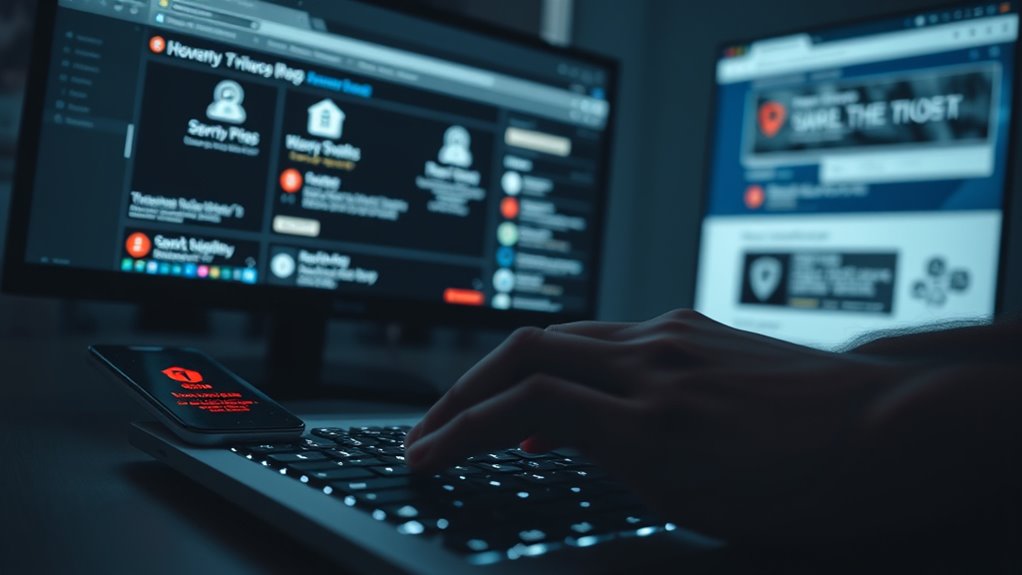Digital privacy isn’t just about keeping secrets; it impacts your identity, finances, and reputation more than you realize. Every time you share personal info or skip security measures, you risk data breaches, identity theft, or fraud that can be costly. Weak passwords, unprotected connections, and careless sharing leave you vulnerable to hackers and scams. By understanding and applying basic privacy habits, you can better protect yourself from threats. Stay with us to discover how to strengthen your digital defenses.
Key Takeaways
- Protecting personal data prevents identity theft, financial loss, and reputational damage from data breaches and exploitation.
- Understanding privacy basics helps individuals recognize and avoid online threats like phishing and social engineering.
- Proper use of encryption and strong passwords safeguards sensitive information from cybercriminals.
- Regular privacy audits and setting controls reduce vulnerability to data sharing and unauthorized access.
- Building privacy habits fosters long-term resilience against evolving cyber threats and maintains trust in digital systems.
The True Cost of Data Breaches

Data breaches can have far-reaching consequences that go beyond just losing sensitive information. When your data is compromised, it can be exploited for data monetization, where malicious actors sell or misuse your details for profit. This can lead to identity theft, financial loss, and damaged reputations. Additionally, organizations face hefty fines and legal action due to non-compliance with privacy legislation, which is becoming stricter worldwide. These laws aim to protect your rights, but they also mean that data breaches can result in significant penalties for companies that fail to safeguard your information. The true cost extends beyond immediate harm, affecting entire industries and eroding trust in digital systems. Staying vigilant and understanding privacy legislation helps you recognize the importance of protecting your personal data. Recognizing the importance of digital privacy basics can help prevent the devastating impacts of data breaches.
How Personal Info Can Be Exploited

Your personal info can be used against you in many ways, like stealing your identity or targeting you with unwanted ads. Hackers and scammers exploit your data to commit fraud or manipulate your choices. Understanding these risks helps you protect yourself from serious consequences. Being aware of cookie management practices and how your data is shared can further enhance your privacy protection.
Identity Theft Risks
Have you ever wondered how easily personal information can be turned into a tool for identity theft? Cybercriminals use social engineering tactics to manipulate you into revealing sensitive data. They often craft convincing phishing scams, pretending to be trustworthy sources like banks or government agencies. By clicking malicious links or sharing details, you unknowingly give scammers access to your personal info. Once they have your data—such as Social Security numbers, bank account details, or passwords—they can impersonate you, open accounts, or make unauthorized transactions. The danger isn’t just financial; it can damage your credit and reputation. Staying vigilant against social engineering tricks and verifying requests before sharing information is vital. Data protection practices and awareness of common scams are essential to prevent falling victim to identity theft risks.
Targeted Advertising Tactics
When cybercriminals gather personal information through social engineering or phishing, they don’t just stop there; they also use it to target you with personalized advertisements. This process relies on behavior tracking, where your online actions are monitored to predict your interests. Advertisers use sophisticated algorithms that analyze your habits, preferences, and even emotional responses. However, these algorithms can exhibit bias, leading to skewed or manipulative ad content tailored specifically to you—sometimes based on incomplete or inaccurate data. This targeted approach isn’t always benign; it can be exploited to manipulate your choices or expose sensitive information. Additionally, understanding the raw food principles and how they relate to personal habits can provide insight into how personal preferences are shaped and targeted. By understanding how your data is used for advertising, you become better equipped to protect your privacy and avoid falling prey to manipulative tactics.
Data Breach Consequences
Data breaches can turn your personal information into a valuable resource for cybercriminals, who often exploit this data for financial gain or malicious purposes. Once your data is compromised, it can lead to identity theft, financial fraud, or even blackmail. Cybercriminals may use weak encryption protocols to access sensitive info or target unprotected accounts. Regular privacy audits help identify vulnerabilities before breaches occur. Here’s how your data can be exploited:
| Exploitation Method | Potential Consequences | Prevention Tips |
|---|---|---|
| Identity Theft | Financial loss, credit damage | Use strong encryption protocols |
| Phishing Attacks | Stolen login info | Conduct regular privacy audits |
| Fraudulent Transactions | Unauthorized purchases | Enable multi-factor authentication |
Additionally, understanding the Cyber Threat Landscape can help you stay ahead of evolving tactics used by cybercriminals.
Protecting Your Digital Identity

Protecting your digital identity starts with safeguarding your personal data and controlling what you share online. You should regularly review and manage your permissions for apps and websites to prevent unnecessary access. By staying vigilant, you can keep your digital footprint secure and maintain your privacy. Additionally, understanding potential risks associated with merchant services can help you make informed decisions about sharing payment information online.
Safeguarding Personal Data
To safeguard your personal data effectively, you need to be proactive about managing your digital identity. Your user behavior shapes your digital footprints, which can reveal sensitive information if left unchecked. To protect yourself, consider these steps:
- Regularly review your privacy settings on social media and online accounts.
- Limit the amount of personal information you share publicly.
- Use strong, unique passwords for different platforms.
- Be mindful of your online activity, avoiding impulsive sharing that could compromise your data.
- Staying informed about emerging digital security threats can help you adapt your privacy practices accordingly.
Managing Online Permissions
Managing online permissions is a crucial step in safeguarding your digital identity because it determines who can access your information and how it’s used. Permission management involves regularly reviewing and adjusting your privacy settings across social media, apps, and online accounts. By controlling permissions, you prevent unnecessary data sharing and limit access to sensitive details. Take time to understand each app’s privacy settings, and disable permissions that aren’t essential. Be cautious when granting access to location, contacts, or camera features. Consistently managing permissions ensures your personal data stays protected and reduces exposure to potential breaches. Remember, your privacy settings are your first line of defense—use them wisely to maintain control over your digital footprint. Additionally, understanding the role of vetted wave and wind can help you stay informed about the latest privacy protections and best practices.
Common Mistakes That Jeopardize Privacy

One of the most common mistakes that can jeopardize your privacy is sharing too much personal information online. Many fall for privacy myths that assume certain details are safe to disclose. Additionally, password pitfalls often compromise security, such as using weak or repeated passwords. To avoid these errors:
- Believing that privacy settings fully protect your data
- Sharing personal info on public forums or social media
- Relying on simple passwords instead of strong, unique ones
- Ignoring the importance of updating passwords regularly
Being aware of interior design principles can also help you organize your online and physical spaces to better safeguard your privacy.
The Role of Encryption and Secure Connections

Sharing too much personal information online can easily expose you to privacy risks, especially if your data isn’t protected by safeguards like encryption. End-to-end encryption guarantees that your messages and data remain private, as only you and the recipient can access the content. When you engage in secure browsing, your connection to websites is encrypted, preventing outsiders from intercepting sensitive information like passwords or credit card details. This layer of security is essential for protecting your online activities from hackers and eavesdroppers. By prioritizing encrypted connections, you reduce the chances of your personal data being compromised. In today’s digital world, understanding how encryption works helps you stay safer and more private during your online interactions, especially when using trusted tools that incorporate encryption to safeguard your data.
Recognizing and Avoiding Online Threats

Since online threats are constantly evolving, remaining vigilant and recognizing the signs of potential dangers is essential. You can protect yourself by honing your awareness of common tactics like social engineering, where attackers manipulate you into revealing sensitive information. To stay safe, focus on these key steps:
- Practice strong password hygiene by creating unique, complex passwords for each account.
- Watch out for suspicious emails or messages that ask for personal details—these often signal social engineering attempts.
- Avoid clicking on unknown links or downloading attachments from untrusted sources.
- Keep your software and security tools updated to patch vulnerabilities that hackers may exploit.
Building Habits for Long-Term Privacy Security

Building lasting privacy security requires establishing consistent habits that become second nature. Start by practicing good password management—use strong, unique passwords for each account and consider a password manager to keep track. Regular privacy audits help you identify vulnerabilities and adjust your settings accordingly. Make it a routine to review your privacy preferences and update passwords periodically. Avoid reusing passwords or sharing sensitive information online. By creating these habits, you reduce the risk of breaches and maintain control over your personal data. Over time, these practices become automatic, strengthening your long-term privacy security. Remember, small daily actions add up, creating a resilient shield against online threats and safeguarding your digital life.
Frequently Asked Questions
How Often Should I Update My Privacy Settings?
You should update your privacy settings at least every few months, especially after major updates or new app installations. Incorporate these into your privacy habits and security routines to stay protected. Regular updates help you manage who accesses your data and prevent vulnerabilities. Don’t forget to review your settings whenever you notice suspicious activity or if platforms change their privacy policies, ensuring your personal information stays secure.
What Are the Signs My Data Has Been Compromised?
Watch for warning signs that your data’s been compromised, like strange account activities or sudden password changes. If you notice suspicious activity or receive alerts about a data breach, it’s a clear sign something’s wrong. Protect yourself by promptly changing passwords, monitoring accounts, and enabling two-factor authentication. Recognizing these signals helps you act swiftly, stopping hackers and securing your digital domain before more damage occurs.
Can Using VPNS Fully Protect My Online Activities?
Using a VPN can enhance your online privacy, but it doesn’t fully protect you. VPN limitations include potential data logging by providers and vulnerabilities if your device is compromised. Many privacy misconceptions suggest VPNs are foolproof, but they aren’t. To stay secure, combine VPN use with safe browsing habits, strong passwords, and updated software. Remember, no single tool guarantees complete privacy, so stay vigilant and informed.
Are Free Security Tools as Effective as Paid Ones?
While free security tools might seem appealing, they often don’t offer the same level of security effectiveness as paid ones. You might get basic protection, but advanced features and reliable updates usually come with a cost. It’s worth considering that investing in reputable paid tools can provide stronger privacy safeguards, giving you peace of mind. Don’t underestimate the value of quality, especially when it comes to your digital privacy.
How Does Digital Privacy Impact My Offline Safety?
Digital privacy directly impacts your offline safety by reducing risks like identity theft and cyberbullying. When you protect your personal information online, you make it harder for criminals to steal your identity or harass you. Staying cautious with what you share and using privacy tools helps safeguard your reputation and physical safety. You’re less vulnerable to offline threats when your digital footprint is secure and private.
Conclusion
Prioritizing privacy isn’t just prudent—it’s powerful. By understanding the risks, resisting reckless routines, and reinforcing your digital defenses, you’ll forge a formidable fortress of security. Small steps, like securing sites and scrutinizing shares, strengthen your stance against sinister scams. Remember, safeguarding your sensitive info isn’t a one-time task; it’s a lifelong lifestyle. Stay savvy, stay secure, and see how simple, steady habits can shield your digital domain from danger.










